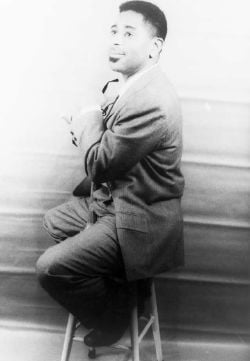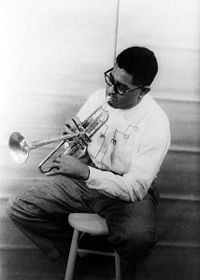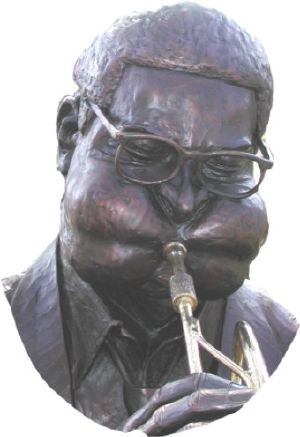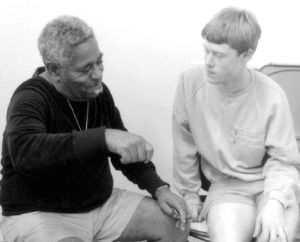Gillespie, Dizzy
Eric Olsen (talk | contribs) |
Eric Olsen (talk | contribs) |
||
| Line 47: | Line 47: | ||
=== Religious inspiration === | === Religious inspiration === | ||
| − | During the long hours of his touring Gillespie, like the revolutionary saxophonist John Coltrane, sought deeper spiritual insight, and began reading endlessly on the Baha'i faith | + | During the long hours of his touring Gillespie, like the revolutionary saxophonist John Coltrane, sought deeper spiritual insight, and began reading endlessly on the Baha'i faith. |
| − | By 1970, Dizzy had become a member of the Baha'i | + | By 1970, Dizzy had become a member of the Baha'i and adapted some of its principles of successive revelation to his perspective of the development of jazz. "Every age in music is important," he said. "Equally as important as the previous one, and is as important as the one that's coming after that. . . . [God's] education of mankind is through these prophets, and each one's supposed to come for a specific age, so they just keep coming, and after his is over another one takes their place. That's what the Baha'is teach you. . . . So I believe that music is the same, too. Messengers come to the music and after their influence starts waning, another one comes with a new idea, and he has a lot of followers."<ref>Alyn Shipton, ''Groovin' High: The Life of Dizzy Gillespie''(Oxford: Oxford University Press, 2001) |
| + | </ref> | ||
"We're supposed to be joyous creatures, here on this earth, and if you're anything but joyous, you're not going by what is meant for you. So I try to get as much enjoyment out of life as possible without hurting anybody. Any music that is written to praise God is good—I don't care what religion it comes under. So there will be, in the future, a groovy number of Baha'is composing music praising God—heavenly music. That's what you get when you're dealing in the spirit. We're dealing in spirit now in jazz. Any work that you do praising God is good. Music, certainly, can transcend the soul to a higher level." | "We're supposed to be joyous creatures, here on this earth, and if you're anything but joyous, you're not going by what is meant for you. So I try to get as much enjoyment out of life as possible without hurting anybody. Any music that is written to praise God is good—I don't care what religion it comes under. So there will be, in the future, a groovy number of Baha'is composing music praising God—heavenly music. That's what you get when you're dealing in the spirit. We're dealing in spirit now in jazz. Any work that you do praising God is good. Music, certainly, can transcend the soul to a higher level." | ||
Revision as of 17:15, 22 December 2008
| John Birks "Dizzy" Gillespie | |
 Dizzy Gillespie in 1955 by Carl Van Vechten.
| |
| Born | October 21, 1917 Cheraw, South Carolina, United States |
|---|---|
| Died | December 25, 2006 Englewood, New Jersey, United States |
| Occupation | Jazz Trumpeter, Bandleader, Singer and Composer |
John Birks "Dizzy" Gillespie (October 21 1917 – January 6 1993)was an American jazz trumpeter, bandleader, singer, and composer. Gillespie, with Charlie Parker, was a major figure in the development of bebop and modern jazz.
Gillespie was a trumpet virtuoso and gifted improviser, building on the style of trumpeter Roy Eldridge but adding layers of harmonic complexity previously unknown in jazz. In addition to his improvisional skills, he was instrumental in founding Afro-Cuban jazz, the modern jazz version of the "Spanish Tinge" originally credited to the jazz pioneer Jelly Roll Morton. Dizzy's beret and horn-rimmed spectacles, his scat singing, his bent horn, pouched cheeks and his light-hearted personality were essential in popularizing bebop, which was originally regarded as threatening and frightening music by many listeners raised on older styles of jazz. He had an enormous impact on virtually every subsequent trumpeter, both by the example of his playing and as a mentor to younger musicians.
Biography
Early life and career
John Birks Gillespie was born October 21, 1917, in Cheraw, South Carolina, the youngest of nine children,to John and Lottie Gillespie. Gillespie's father was strict and often abusive, although he also owned and played a number of instruments. When Gillespie was ten, his father died and left the family in terrible financial trouble.
Gillespie soon joined the school band, at first playing the trombone but soon switching to the trumpet. Gillespie largely taught himself to play and won a scholarship to the Laurinburg Institute in North Carolina. However, he dropped out of school in 1935, moved to Philadelphia, Pennsylvania, hoping to work as a full-time musician. Gillespie first joined Frankie Fairfax, and made his recording debut filling for Roy Eldridge in Teddy Hill's band. His sometimes eccentric behavior—such as carrying his new trumpet in a paper bag—earned him the nickname "Dizzy."
Gillespie moved to New York City in 1937. At age nineteen Gillespie was already gaining notice, and notoriety, among New York musicians, for his radically original trumpet solos. Gillespie made his first recordings with the Teddy Hill Orchestra, then joined a tour of Europe with "The Cotton Club Show." After finding work with Cab Calloway's group, Gillespie was soon being excoriated for his adventurous solos by his employer, who branded it "Chinese music." He lost the spot in Calloway's band for an unrelated reason, however: Calloway accused Gillespie of firing a spitball at him during a concert, and the hot-headed Gillespie stabbed Calloway in the leg with a small knife. Gillespie went through many bands including Duke Ellington's, and also arranged music for Woody Herman. Gillespie first met saxophonist Charlie Parker in Kansas City, Missouri, in 1940 while touring with Calloway.
The legendary big band of Billy Eckstine gave his unusual harmonies a better setting, and it was as a member of Eckstine's band that he was reunited with Parker, after earlier being members of Earl "Fatha" Hines's more conventional band.
The rise of bebop
With Charlie Parker, Gillespie jammed at famous jazz clubs like Minton's Playhouse and Monroe's Uptown House, where the first seeds of bebop were planted. Gillespie's compositions like "Groovin' High," "Woody n' You," "Anthropology," "Salt Peanuts," and "A Night in Tunisia" sounded radically different, harmonically and rhythmically, than the Swing music popular at the time.
After leaving Eckstine, Gillespie formed his own group for an engagement at the Onyx Club on 52nd Street. The 52nd Street clubs effectively launched a new jazz style that had previously been played privately at late night jam sessions. "The opening of the Onyx Club represented the birth of the bebop era," Gillespie wrote in his book, To Be or Not to Bop. Describing the new approach, Gillespie wrote, "We'd take the chord structures of various standard and pop tunes and create new chords, melodies, and songs from them."
Gillespie influenced many of the young musicians on 52nd Street, like Miles Davis and Max Roach, about the new style of jazz. After a lengthy gig at Billy Berg's club in Los Angeles, though, which left most of those in the audience ambivalent or hostile towards the new music, the band broke up.
After his work with Parker, Gillespie led other small combos (including ones with Milt Jackson, John Coltrane, Lalo Schifrin) and finally put together his first successful big band. While bebop musicians tended to favor small combos, Gillespie wanted to lead a large format group because he feared that the music he helped create was becoming too obtuse and wanted to prove that it could still be danceable. He also appeared frequently as a soloist with Norman Granz's Jazz at the Philharmonic.
While Dizzy and his orchestra flourished, other bands formerly playing swing began to try bebop instead. By 1950 the movement of big bands towards bebop had peaked and declined, and Gillespie found himself unable to financially maintain his large format group. In March 1952, Gillespie left for France after being invited by Charles Delaunay to play on Salon du Jazz.[1] Gillespie did not have any other commitments during his time in Paris and therefore embarked on his Blue Star sessions and started to assemble his third big band. Due to his prior success he could now record in the finest studios like Théatre des Champs-Elysées. In 1953 he returned to the United States after a series of successful concerts and recordings. In 1956 he organized a band to go on a State Department tour of the Middle East and earned the nickname "the Ambassador of Jazz."[2]
In the late 1940s, Gillespie was also involved in the movement called Afro-Cuban music, bringing Latin and African elements to greater prominence in jazz and even pop music, particularly salsa. In addition to Gillespie's compositions "Manteca" and "Tin Tin Deo," he was responsible for commissioning George Russell's "Cubano Be, Cubano Bop," which featured the great but ill-fated Cuban conga player, Chano Pozo. In 1977, Gillespie discovered Arturo Sandoval while researching music during a tour of Cuba.
Religious inspiration
During the long hours of his touring Gillespie, like the revolutionary saxophonist John Coltrane, sought deeper spiritual insight, and began reading endlessly on the Baha'i faith.
By 1970, Dizzy had become a member of the Baha'i and adapted some of its principles of successive revelation to his perspective of the development of jazz. "Every age in music is important," he said. "Equally as important as the previous one, and is as important as the one that's coming after that. . . . [God's] education of mankind is through these prophets, and each one's supposed to come for a specific age, so they just keep coming, and after his is over another one takes their place. That's what the Baha'is teach you. . . . So I believe that music is the same, too. Messengers come to the music and after their influence starts waning, another one comes with a new idea, and he has a lot of followers."[3]
"We're supposed to be joyous creatures, here on this earth, and if you're anything but joyous, you're not going by what is meant for you. So I try to get as much enjoyment out of life as possible without hurting anybody. Any music that is written to praise God is good—I don't care what religion it comes under. So there will be, in the future, a groovy number of Baha'is composing music praising God—heavenly music. That's what you get when you're dealing in the spirit. We're dealing in spirit now in jazz. Any work that you do praising God is good. Music, certainly, can transcend the soul to a higher level."
Later years and death
Unlike his contemporary Miles Davis, who went in new directions, first as the leading exponent of cool jazz and later into experimental fusion jazz, Gillespie essentially remained true to the bebop style for the rest of his career. Gillespie's tone gradually faded in the last years in life, and his performances often focused more on his proteges such as Arturo Sandoval and Jon Faddis; his good-humoured comedic routines became more and more a part of his live act.
Gillespie remained prodigiously busy until late in life. In 1989 Gillespie gave 300 performances in 27 countries, appeared in 100 U.S. cities in 31 states and the District of Columbia, headlined three television specials, performed with two symphonies, and recorded four albums. He was also crowned a traditional chief in Nigeria, received the Commandre d'Ordre des Artes et Lettres—France's most prestigious cultural award—was named regent professor by the University of California, and received his fourteenth honorary doctoral degree, this one from the Berklee College of Music. In addition, he was awarded the Grammy Lifetime Achievement Award the same year. The next year, at the Kennedy Center for the Performing Arts ceremonies celebrating the centennial of American jazz, Gillespie received the Kennedy Center Honors Award and the American Society of Composers, Authors, and Publishers Duke Ellington Award for 50 years of achievement as a composer, performer, and bandleader.[4][5] He has a star on the Hollywood Walk of Fame at 7057 Hollywood Boulevard in the Hollywood secton of the City of Los Angeles.
November 26, 1992, at Carnegie Hall in New York, following the Second Bahá'í World Congress was Dizzy's 75th birthday concert and his offering to the celebration of the centenary of the passing of Bahá'u'lláh. Gillespie was to appear there at Carnegie Hall for the 33rd time. The line-up included: John Faddis, Marvin "Doc" Holladay, James Moody, Paquito D'Rivera, and the Mike Longo Trio with Ben Brown on bass and Mickey Roker on drums. But Gillespie didn't make it because he was in bed suffering from cancer of the pancreas. "But the musicians played their hearts out for him, no doubt suspecting that he would not play again. Each musician gave tribute to their friend, this great soul and innovator in the world of jazz."[6]
He died of pancreatic cancer in 1993 in Englewood, New Jersey, aged 75, and was buried in the Flushing Cemetery, Queens, New York. Mike Longo delivered a eulogy at his funeral. He was also with Gillespie on the night he died.
At the time of his death, Dizzy was survived by his widow, Lorraine Willis Gillespie, a daughter, jazz singer Jeanie Bryson, and a grandson, Radji Birks Bryson-Barrett. Gillespie had two funerals. One was a Bahá´í funeral at his request, at which his closest friends and colleagues attended. The second was at the Cathedral of St. John the Divine in New York attended by the world.[7]
Legacy
Gillespie was known for playing a trumpet whose bell was bent upwards at a 45 degree angle. Originally the result of accidental damage, the constriction caused by the bending altered the tone of the instrument, and Gillespie liked the effect. For the rest of his career he would have trumpets constructed for him with the bell intentionally tilted upwards. The bent-bell trumpet became his signature instrument and a part of his iconic image.
Dizzy Gillespie developed a virtuosic mastery of the trumpet and a technique that was viewed as ahead of its time:
If Armstrong had expanded the reach of instrumental technique for his generation making more things possible, then Gillespie seemed to reach the final theoretical point of command that made all things possible, effectively ending the arms race of capacity that had driven jazz for two decades. His speed, articulation, and sense of surprise showed up in many bebop trumpet players in the years after 1946, but few doubted that he was the master and matrix of it all.[8]
In addition to Gillespie's instrumental prowess and musical innovation, his lively personality and openness to share his methods and approaches with others helped to ensure his enduring legacy. This collabrative, mentoring and engaging nature was a characteristic that set him apart from some his contemporaries involved in the formation of bebop and thus modern jazz:
Unlike Bird, Dizzy was an enthusiastic teacher who wrote down his musical innovations and was eager to explain them to the next generation, thereby insuring that bebop would eventually become the foundation of jazz.[9]
His personability and his public nature made him a natural ambassador figure both for jazz music (his tours under the auspices of the State department were extremely successful), and for the Baha'i Faith which became so important to him in the latter part of his life. A Bahá'í since 1970, Dizzy Gillespie was one of the most famous adherents of the Bahá'í Faith. The religion helped him make sense of his position in a succession of trumpeters as well as turning his life from knife-carrying roughneck to global citizen, and from alcohol to soul force, in the words of author Nat Hentoff, who knew Gillespie for forty years.[10][11][12] He is honored with weekly jazz sessions at the New York Bahá'í Center.[13]
In light of his remarkable technical ability, his melodic, harmonic, and stylistic innovations and his charisma and band-leading skills, Dizzy Gillespie is widely considered one of the greatest jazz trumpeters of all time,[14] comparable in stature to Miles Davis and Louis Armstrong, and is one of the most well known, admired and accomplished American musicians of the twentieth century.
ReferencesISBN links support NWE through referral fees
- Maggin, Donald L. Dizzy: The Life and Times of John Birks Gillespie. NY: HarperCollins, 2005. ISBN 0-060-55921-2
- Gillespie, Dizzy with Al Fraser. To Be or Not to Bop: Memoirs—Dizzy Gillespie. NY: Doubleday, 1979. ISBN 0-385-12052-4
- Gitler, Ira. The Masters of Bebop: A Listener's Guide. NY: Da Capo, 2001. ISBN 0-306-81009-3
- Shipton, Alyn. Groovin' High: The Life of Dizzy Gillespie. NY: Oxford University Press, 1999. ISBN 0-195-14410-4
Footnotes
- ↑ Alain Tercinet, Booklet of The Great Blue Star Sessions 1952-1953.
- ↑ from Ken Burns's Jazz, A Gillespie Biography Retrieved May 31, 2008.
- ↑ Alyn Shipton, Groovin' High: The Life of Dizzy Gillespie(Oxford: Oxford University Press, 2001)
- ↑ Pop/Jazz; A Tribute For Gillespie And the Jazz He Created Retrieved May 31, 2008.
- ↑ Jazz with Bob Parlocha - Biographies - Dizzy Gillespie Retrieved May 31, 2008.
- ↑ The Spiritual Side of Dizzy by Lowell Johnson Retrieved May 31, 2008.
- ↑ Dizzy Gillespie Memorial Retrieved May 31, 2008.
- ↑ The African American Registry Retrieved May 31, 2008.
- ↑ allmusic.com page Retrieved May 31, 2008.
- ↑ Remembering Dizzy Retrieved May 31, 2008.
- ↑ Groovin' High The Life of Dizzy Gillespie by Alyn Shipton. Retrieved May 31, 2008.
- ↑ Groovin' High: The Life of Dizzy Gillespie Review by Brad Pokorny. Retrieved May 31, 2008.
- ↑ Jazz at the Bahá'í Center Retrieved May 31, 2008.
- ↑ 30 Greatest Jazz Trumpet Players Retrieved May 31, 2008.
External links
- The African American Registry - The heart of jazz, Dizzy Gillespie Retrieved July 23, 2007.
- Dizzy Gillespie's "The Cult of Bebop" Retrieved July 23, 2007.
- Dizzy Gillespie Talking to Les Tomkins in 1973 Retrieved July 23, 2007.
Credits
New World Encyclopedia writers and editors rewrote and completed the Wikipedia article in accordance with New World Encyclopedia standards. This article abides by terms of the Creative Commons CC-by-sa 3.0 License (CC-by-sa), which may be used and disseminated with proper attribution. Credit is due under the terms of this license that can reference both the New World Encyclopedia contributors and the selfless volunteer contributors of the Wikimedia Foundation. To cite this article click here for a list of acceptable citing formats.The history of earlier contributions by wikipedians is accessible to researchers here:
The history of this article since it was imported to New World Encyclopedia:
Note: Some restrictions may apply to use of individual images which are separately licensed.


